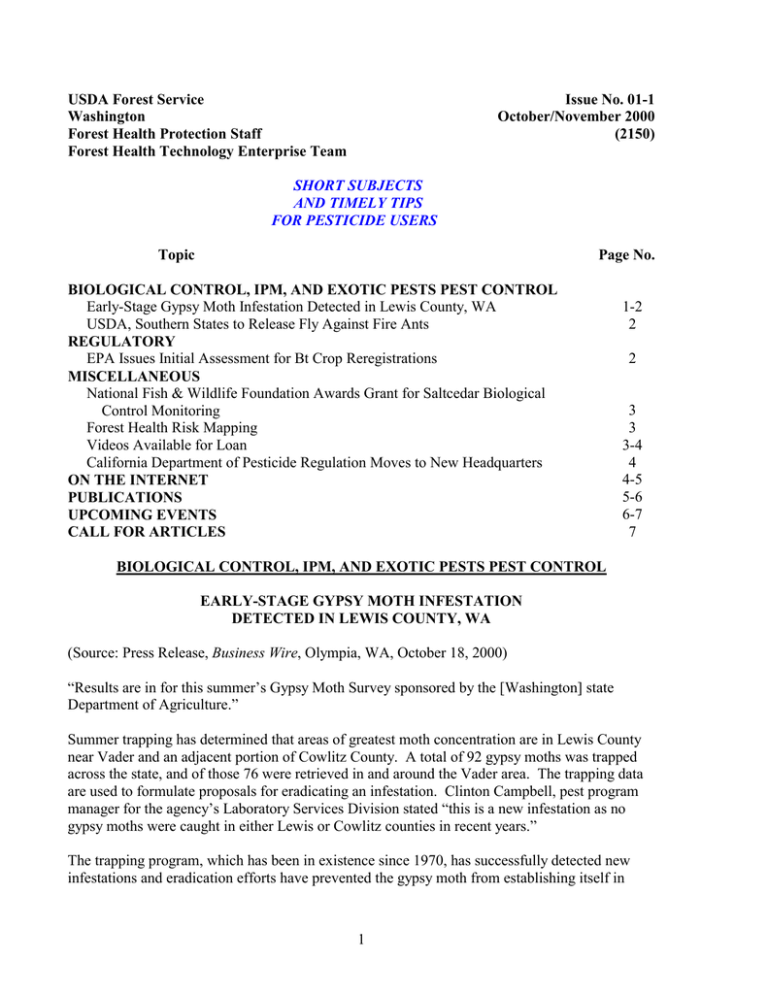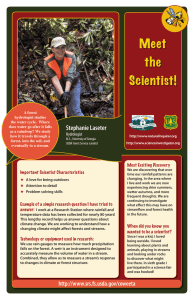USDA Forest Service Issue No. 01-1 Washington October/November
advertisement

USDA Forest Service Washington Forest Health Protection Staff Forest Health Technology Enterprise Team Issue No. 01-1 October/November 2000 (2150) SHORT SUBJECTS AND TIMELY TIPS FOR PESTICIDE USERS Topic Page No. BIOLOGICAL CONTROL, IPM, AND EXOTIC PESTS PEST CONTROL Early-Stage Gypsy Moth Infestation Detected in Lewis County, WA USDA, Southern States to Release Fly Against Fire Ants REGULATORY EPA Issues Initial Assessment for Bt Crop Reregistrations MISCELLANEOUS National Fish & Wildlife Foundation Awards Grant for Saltcedar Biological Control Monitoring Forest Health Risk Mapping Videos Available for Loan California Department of Pesticide Regulation Moves to New Headquarters ON THE INTERNET PUBLICATIONS UPCOMING EVENTS CALL FOR ARTICLES 1-2 2 2 3 3 3-4 4 4-5 5-6 6-7 7 BIOLOGICAL CONTROL, IPM, AND EXOTIC PESTS PEST CONTROL EARLY-STAGE GYPSY MOTH INFESTATION DETECTED IN LEWIS COUNTY, WA (Source: Press Release, Business Wire, Olympia, WA, October 18, 2000) “Results are in for this summer’s Gypsy Moth Survey sponsored by the [Washington] state Department of Agriculture.” Summer trapping has determined that areas of greatest moth concentration are in Lewis County near Vader and an adjacent portion of Cowlitz County. A total of 92 gypsy moths was trapped across the state, and of those 76 were retrieved in and around the Vader area. The trapping data are used to formulate proposals for eradicating an infestation. Clinton Campbell, pest program manager for the agency’s Laboratory Services Division stated “this is a new infestation as no gypsy moths were caught in either Lewis or Cowlitz counties in recent years.” The trapping program, which has been in existence since 1970, has successfully detected new infestations and eradication efforts have prevented the gypsy moth from establishing itself in 1 Washington. For a copy of the press release contact Pat Skyler, (916) 454-0817, pskyler@fs.fed.us or for additional information on the program – CONTACT: DR. CLINTON CAMPBELL or LINDA WARING (360) 902-2071 (360) 902-1815 USDA, SOUTHERN STATES TO RELEASE FLY AGAINST FIRE ANTS (Source: PCT Online, November 22, 2000) “CORAL GABLES, Fla. – Phorid flies, parasites that decapitate imported fire ants, will be massreared beginning this spring for release in fire-ant-infested southern United States in a new biological control initiative.” “The campaign pitting fly against fire ants is part of a five-year program” being conducted by the USDA Agricultural Research Service, USDA Animal and Plant Health Inspection Service, and the Florida Department of Agriculture and Consumer Services. Fire ants arrived in the United States in the 1930’s and have now established themselves on 310 million acres in the South causing billions of dollars in agricultural losses, ecological damage and control costs. For a copy of the press release – CONTACT: PAT SKYLER (CA) (916) 454-0817 pskyler@fs.fed.us REGULATORY EPA ISSUES INITIAL ASSESSMENT FOR Bt CROP REREGISTRATIONS (Source: Pesticide & Toxic Chemical News, September 28, 2000) “Corn, cotton and potatoes modified to produce Bacillus thuringiensis (Bt) – a natural pesticide with 50 years of commercial and residential use – have cleared their first reregistration hurdle, says EPA’s Office of Pesticide Program’s preliminary risk and benefits (R&B) assessment for the self-protecting crops.” The assessment is available on the EPA Scientific Advisory Panel website at < http://www.epa.gov/scipoly/sap/#october>. For a copy of this article – CONTACT: PAT SKYLER (CA) (916) 454-0817 pskyler@fs.fed.us 2 MISCELLANEOUS NATIONAL FISH & WILDLIFE FOUNDATION AWARDS GRANT FOR SALTCEDAR BIOLOGICAL CONTROL MONITORING “The U.S. Fish and Wildlife Service, National Wildlife Refuge System, Portland, OR received a $180,000 grant (September 6, 2000) from the National Fish and Wildlife Foundation (NFWF) for the “Monitoring of Insect, Vegetation, and Wildlife Response to Biological Control of Invasive Saltcedar, Tamarix ramosissima, at 10 Western Sites in TX, CO, WY, UT, NV, and CA.” The Saltcedar Consortium members will use the funds where the saltcedar leaf beetle, Diorhabda elongata, is located. The grant consists of two parts: $120,000 (match) and $60,000 (NFWF funds). The Consortium must raise the $120,000 match (non-federal funds) in order to get the full grant amount of $180,000. For additional information about this grant – CONTACT: SCOTT STENQUIST (OR) (503) 231-6172 scott_stenquist@fws.gov FOREST HEALTH RISK MAPPING (Source: USDA Forest Service, Forest Health Protection website) “Purpose - The purpose of the risk mapping effort is to help determine where national attention may be needed to address forest health. The forest insect and disease risk map is one of several layers of information needed to provide a national representation of forest health. Other national maps (fire, wildland/urban, and threatened and endangered species) are under development.” The forest health risk mapping effort which was initiated by the USDA Forest Service in 1996 “to help determine where additional national attention may be needed,” now has a website which includes the map Forest Lands Most at Risk to Insects and Diseases that “identifies 70 million acres at risk from 26 insects and diseases.” The website is located at <http://www.fs.fed.us/foresthealth/risk_maps/risk_maps.html> For additional information – CONTACT: JOE LEWIS (WO) (202) 205-1597 jlewis02@fs.fed.us VIDEOS AVAILABLE FOR LOAN The following videos have recently been added to the USDA Forest Service Video Library and are available for loan at no charge other than S&H: Monitoring Methods for Knapweed (17 min). Knapweed has rapidly spread over a large portion of the Western United States during the past 80 years. Biological control in the form of insects that specifically attack knapweed is an important part of controlling this noxious weed. This video describes monitoring methods for both root feeding and seed head feeding insects that 3 have been released for biological control of knapweed. The viewer will learn how to monitor for these insects using easy and effective techniques. Using a consistent monitoring approach allows us to determine if the insect is established, is spreading from the original point of release, and is having an impact on the knapweed. Fading Gold: The Decline of Aspen in the West (12 min – closed-captioned). In the Rocky Mountain West, one of our most important tree species is fading from the landscape. Quaking Aspen once covered almost nine million acres, now they cover less than four million acres. This program describes the unique biology of Aspen and how it is tied to its decline. For every acre of Aspen lost, so is a prime source of water, productive habitat for wildlife, a valuable source of livestock forage, and one of our most scenic treasures. Lake Tahoe: Working Together to Preserve a National Treasure (21 min – close-captioned). In the early 1990’s, the waters of Lake Tahoe were the focus of much discord. By the year 2000, Tahoe’s diverse communities had become united in their commitment to save the lake. The famous clear blue waters of this lake have been rapidly diminishing, losing a foot of clarity per year for the last thirty years. This video explores some of the problems and potential solutions to this pressing issue. Contact the library at (800) 683-8366. For a complete list of videos available, visit their website at: < http://www.r5.fs.fed.us/video/> CALIFORNIA EPA’s DEPARTMENT OF PESTICIDE REGULATION MOVES TO NEW HEADQUARTERS Between December 7 and 15, 2000 the three divisions of the California DPR will move to the new Cal/EPA high-rise at 10th and I Streets in downtown Sacramento. Their new address will be 1001 I Street, Sacramento, CA 95814-2828, mailing address P.O. Box 4015, Sacramento 958124015. Phone numbers will remain the same. ON THE INTERNET The Purple Pages is the homepage of the Purple Loosestrife Project at Michigan State University. To learn more about this biological control project, “which engages citizens and young adults in the control of purple loosestrife using the plant’s own natural enemies” log onto the website at <http://www.msue.msu.edu/seagrant/pp/index.html> _______________ Compiled by the Agricultural Research Service, the new Invaders Database System is the firstever database on invasive weeds. It provides exotic plant names and historical weed distribution records for five northwestern states and details occurrences of new, invasive weeds in 48 states and six Canadian provinces. The database is located at the University of Montana’s “INVADERS” website <http://invader.dbs.umt.edu/>. For more information – CONTACT: KERRI SKINNER (MT) (406) 433-9484 kskinner@sidney.ars.usda.gov 4 “The Exotic Forest Pest Information System for North America identifies exotic insects, mites and pathogens with potential to cause significant damage to North American forest resources. The database contains background information for each identified pest and is intended to serve as a resource for regulatory and forest protection agencies in North America.” The Information System is a joint project of the member organizations of the Insect and Disease Study Group of the North American Forest Commission. Member organizations include the Canadian Forest Service, the Canadian Food Inspection Agency, Secretaria del Medio Ambiente, Recursos Naturales y Pesca (SEMARNAP: Sanidad Forestal), the USDA Forest Service, and the USDA Animal and Plant Health Inspection Service. The project is managed by representatives of each organization. The site can be accessed at <http://www.exoticforestpests.org/english/background.htm> _______________ OWOW Invasive Species Program has a new website. EPA’s Office of Wetlands, Oceans and Watersheds (OWOW) is part of a government-wide effort to address the threat to US waters and ecosystems by the uncontrolled spread of invasive species. Visit their website at <http://www.epa.gov/owow/invasive_species/> _______________ The National Service Center for Environmental Publications (NSCEP) has over 5,000 EPA publications available in hardcopy and multimedia product, free of charge. To browse the site, log on at: <http:www.epa.gov/ncepihom/> PUBLICATIONS For a copy of the following publications contact Pat Skyler (916) 454-0817, Email: pskyler@fs.fed.us Mountain Meteorology: Fundamentals and Applications, Oxford University Press, New York and Oxford. The book, authored by C. David Whiteman, is written for the resource manager whose everyday field work is influenced positively or negatively by weather. It is published in hardback and contains 355 pages of text and color illustrations. Sections of the book include: Mountain Climates, Atmosphere Descriptions, Mountain Winds, Applications – prescribed fire, fire weather in complex terrain, critical fire weather, monitoring fire, smoke management and aerial spraying. Free copies are still available as long as supplies last, so request your copy or copies today. Parker, D. and M. Williamson. Low-Impact, Selective Herbicide Application for Control of Exotic Trees in Riparian Areas: Saltcedar, Russian-Olive and Siberian Elm: A preliminary field guide. 2000. USDA Forest Service, Southwestern Region, Albuquerque, NM. Potter, W.D., W. Bi, D.B. Twardus, H.W. Thistle, J. Ghent, M. Twery and M.E. Teske. 2000. Aerial Spray Deposition Management Using the Genetic Algorithm. (Best Paper Award). 5 Proceedings of the 13th Conference on Industrial & Engineering Applications of Artificial Intelligence & Expert Systems, International Society of Applied Intelligence, San Marcos, TX. Pesticides and Planning for Emergencies: Prevention, Reaction, and Response is a new handbook from Purdue University. The 112-page book helps evaluate your risks and prepare a plan for pesticide emergencies ranging from spills to fires. The handbook is available on-line, http://www.btny.purdue.edu/PPP/PPP_pubs.html (publication #PPP-44), or order a hard copy for $30 by calling 888-398-4636. (Source: Pest Management Newsletter, October 2000) UPCOMING EVENTS 16-18 January 2001. 22nd Annual Forest Vegetation Management Conference: Water, Aquatic Resources, and Vegetation Management, Holiday Inn, Redding, CA. Contact: Sherry Cooper (530) 224-4902, Email: shcooper@ucdavis.edu 16-19 January 2001. USDA Interagency Research Forum on Gypsy Moth and Other Invasive Species, Loews Annapolis Hotel, 126 West Street, Annapolis, MD 21401. Contact: Kathy McManus, USDA Forest Service, NERS, 51 Mill Pond road, Hamden, CT 06514, (203) 230-4330, email: kmcmanus@fs.fed.us 5-8 February 2001. Forest Health Monitoring Workshop, Las Vegas, NV. Contact: Ken Stolte (919) 549-4022, Email: kstolte@fs.fed.us or Kurt Riitters (919) 549-4015, Email: kriitters@fs.fed.us 11-14 February 2001. Weed Science Society of America – 2001 Annual Meeting, Greensboro, NC. Contact: Rhonda Green (800) 627-0629 or (785) 843-1235, E-mail: wssa@allenpress.com or visit their website at <http://ext.agn.uiuc.edu/wssa/wssagg.html> 23 February 2001. Lyme Disease in California and the Wildlife Profession Workshop, Raddisson Hotel, Sacramento, CA. Contact: Kent Reeves (209) 365-1096 or Dr. Reg Barrett (510) 642-7261. 13-15 March 2001. Western Society of Weed Science, The Coeur d’Alene Resort, Coeur d’Alene, ID. For information, visit their website at <http://www.wsweedscience.org/annual_meet/meeting_index.html> 15-16 March 2001. The First International Knapweed Symposium of the New Millennium, The Coeur d’Alene Resort, Coeur d’Alene, ID. Contact: Linda Wilson at lwilson@uidaho.edu, Barb Mullin (406) 444-5400, or Rita Beard (970) 295-5745 or visit their website at: <http://www.sidney.ars.usda.gov/knapweed>. 14-18 May 2001. North American Forest Insect Work Conference, Crown Plaza-Chateau Lacombe Hotel, Edmonton, Alberta. Contacts: Jan Volney (780) 435-7329, Hideji Ono (780) 427-8474, John Spence (780) 492-3003 or check out their website at <http://nofc.cfs.nrcan.gc.ca/nafiwc/> 6 30 July – 2 August 2001. The Western Forest Genetics Association 2001 Conference, University of California, Davis, CA. The conference is hosted by the Institute of Forest Genetics, Pacific Southwest Research Station, USDA Forest Service. Contact: Dr. David Neale, (530) 754-8431, Email: dneale@dendrome.ucdavis.edu or visit their website at: <http://dendrome.ucdavis.edu/ifg/WFGA/wfga.htm> 2-5 August 2001. The Practice of Biological Control: Importation and Management of Natural Enemies in the New Millennium, Bozeman, MT. For additional information contact: Tim Kring (501) 575-3186. 10-14 September 2001. Dynamics of Forest Insect Populations, University of Aberdeen, Aberdeen, Scotland. Contact: Andrew Liebhold, USDA Forest Service, Morgantown, WV, (304) 285-1512, Email: sandy@gypsy.fsl.wvu.edu or visit their website at http://salava.metla.fi/iufro/iufronet/d7/wu70307/aberdeen_firstannounce.htm CALL FOR ARTICLES Please forward to me all articles, meeting announcements, publications, reports, or other items of interest that you would like included in the next issue of Short Subjects & Timely Tips for Pesticide Users. Please include the name, State, and telephone number of the individual who can be contacted for further information: CONTACT: PAT SKYLER (CA) (916) 454-0817/Fax (916) 454-0820 Email: pskyler@fs.fed.us _________________________ The Washington Office, Forest Health Protection, Forest Health Technology Enterprise Team sponsors, compiles, edits, and distributes this informal newsletter as a means of providing current information to forestry pesticide users. Comments, questions, and items of input are welcome and may be sent to Pat Skyler, Editor, USDA Forest Service, Remote Sensing Lab, 1920 20th Street, Sacramento, CA 95814, or by E-mail: <pskyler@fs.fed.us>. Reference to a commercial product or source in this newsletter does not constitute endorsement by the USDA Forest Service. Information should be verified by contacting the original source of information as neither the editor nor the USDA Forest Service guarantees the accuracy of the information provided in this newsletter. Pesticides can be injurious to humans, domestic animals, desirable plants, and fish or wildlife if they are not handled or applied properly. Use all pesticides in accordance with label precautions. 7

